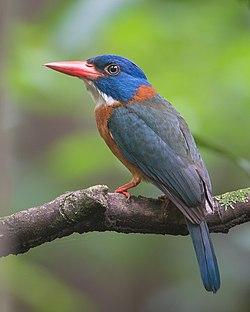| Actenoides | |
|---|---|
 | |
| Green-backed kingfisher (Actenoides monachus) | |
| Scientific classification | |
| Domain: | Eukaryota |
| Kingdom: | Animalia |
| Phylum: | Chordata |
| Class: | Aves |
| Order: | Coraciiformes |
| Family: | Alcedinidae |
| Subfamily: | Halcyoninae |
| Genus: | Actenoides Bonaparte, 1850 |
| Species | |
see text | |
| Phylogeny |
| Cladogram based on the molecular analysis by Andersen and colleagues published in 2017. [1] |
Actenoides is a genus of kingfishers in the subfamily Halcyoninae.
The genus Actenoides was introduced by the French ornithologist Charles Lucien Bonaparte in 1850. The type species is Hombron's kingfisher (Actenoides hombroni). [2] The name of the genus is from the Ancient Greek aktis, aktinos for "beam" or "brightness" and -oidēs for "resembling". [3] A molecular study published in 2017 found that the genus Actenoides, as currently defined, is paraphyletic. The glittering kingfisher in the monotypic genus Caridonax is a member of the clade containing the species in the genus Actenoides. [1]















